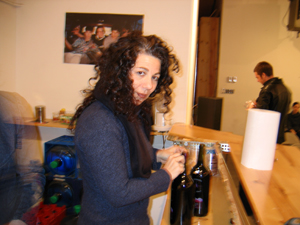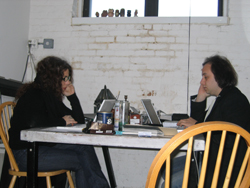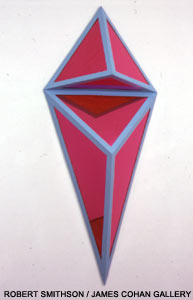
Suzanne Fiol at ISSUE Project Room's original East 6th Street location, December 2004
|
|
On October 5, 2009, Suzanne Fiol, the founder and artistic director of the Brooklyn performance venue ISSUE Project Room, died after a year-long battle with cancer. She was 49 years old. She leaves behind her daughter Sarah, her sister Nancy, her parents Lawrence and Arlene Perlstein, and her partner Anthony Coleman. Known to all as a fiercely passionate advocate, Suzanne's passing is an utterly profound loss for the experimental arts community. She possessed an insatiable curiosity and nurturing spirit—qualities that sustained ISSUE through various growing pains and the vicissitudes of presenting avant-garde art, and continue to drive its eventual move to a permanent home in downtown Brooklyn.
The fabric of Suzanne's personality and spirit are woven into every inch of the ISSUE Project Room quilt. Her background outside the field of music as both an esteemed photographer (with works in the permanent collections of The Art Institute of Chicago and The Brooklyn Museum, among others) and a commercial gallerist afforded Suzanne a singular, artist-centric perspective. What ISSUE at times lacked in production materials and funding in its early days on East 6th Street was exponentially made up for with old school hospitality, collegial camaraderie, and genuine respect for the various artistic languages and voices being explored. Like Suzanne, ISSUE successfully straddles the precarious line between challenging aesthetic concepts and a personal connection to the art with a relaxed, inviting demeanor that welcomes novices and initiates alike.
I was aware of ISSUE Project Room fairly early on. Looking at the
online performance archive from IPR's earliest days clarifies how it arrived on my radar. In typical fashion, Suzanne had garnered the support of many preeminent Downtown artists to kick off the space such as Marc Ribot, Elliott Sharp, The Jazz Passengers with Deborah Harry, and Anthony Coleman. I was curating at The Kitchen at that time, and before even attending a show at IPR I sensed the forming of a venue reminiscent of that venerable institution's beginnings. After spending time there, I did feel the sort of collective, like-minded energy that I imagine existed in the SoHo scene circa 1972. In any case, Suzanne and her staff had successfully created a professional/personal space for people to get to know each other, and I was delighted to be a part of it.

Suzanne with IPR Production Director Zach Layton, January 2008
|
|
Personally, over the past six years, I've created some of my best work as an artist and curator at ISSUE Project Room, and I owe Suzanne a great deal for the opportunity to bring these projects to life. As she did with so many artists, Suzanne supported my ideas unconditionally and afforded me the time and space to manifest them in any way that I saw fit. As ISSUE's first
Artists-In-Residence during the Spring of 2006, the ensemble Ne(x)tworks found its group voice while presenting works by composers including myself, Joan La Barbara, Kenji Bunch, Cornelius Dufallo, and Julius Eastman. The work we did over three important events led to many future opportunities and a greater profile in the field. In July of 2006, Suzanne took a true leap of faith in agreeing to present two seven-hour performances by choreographer Yoshiko Chuma's School of Hard Knocks and my trombone septet. The work,
Sundown, encompassed IPR's entire Carroll Street compound, with simultaneous performances inside the famous silo space and on the banks of the Gowanus Canal. It was an incredible weekend of interdisciplinary art making, and it couldn't have happened anywhere but ISSUE Project Room.
I believe that Suzanne's steadfast faith in the people and community around her will be her most lasting legacy. From the very start, she wanted ISSUE to be a place for serious artists to experiment, innovate, and push their own boundaries. This attitude is in very short supply in these high-pressure times in which ticket and bar sales seem paramount. Thankfully, Suzanne's wonderful legacy has an opportunity to carry on with the advent of IPR's new space at 110 Livingston. It will be a bittersweet triumph for some when the "Carnegie Hall of the Avant-Garde" opens sometime next year, but it will indeed be Suzanne's triumph. She did all that she could possibly have done to make it a reality, and for that we will all be eternally grateful.

Cornelius Dufallo (left), Suzanne, Yves Dharamraj (right) at IPR's James Tenney celebration (May 2005)
|
|
One of my biggest regrets with her passing is that my 14-month old son Arav will live his life not having known Suzanne. To many in our community she truly was "Mama ISSUE." She was someone that I hoped he would get to know very well, a beloved extended family member that he could look up to and admire. Her loss is a real tragedy, and one that I may never be able to reconcile.
I believe that Suzanne Fiol the artist, curator, and mother was guided by a true reverence for the sublime. As with many people who spend their lives searching for aesthetic bliss, she could be charmingly impractical and perhaps even maddeningly irascible. But these were forgivable and forgettable peccadilloes: Suzanne is one of the warmest souls I've ever met and I will miss her deeply for the rest of my life.
We all love and miss you Suzanne. Rest in peace.

Suzanne, CJM, Curtis Hasselbring, Steve Swell, Peter Zummo, Jacob Garchik, Peter Evans, and Richard Marriott


